In 2025, content is king—and video content reigns supreme. Whether you’re just starting your vlogging journey or you’re a seasoned creator looking to upgrade your gear, the camera you choose can make or break your content quality.
Elevate your vlogging game with the latest generation of cameras built specifically for creators. As content creation continues to surge across platforms like YouTube, TikTok, and Instagram, having the right camera is no longer optional—it’s essential.
The right vlogging camera does more than just record—it improves your video clarity, ensures smoother footage, enhances audio, and keeps your audience engaged with crisp visuals and pro-level features.
In this guide, we’ll walk you through the Best Camera for Vlogging of 2025.
Top Vlogging Cameras of 2025
1. DJI Osmo Pocket 3 – Best All-in-One Pocket Vlogging Camera
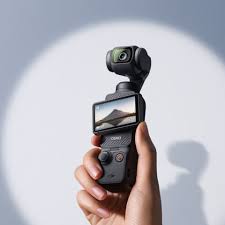
- Sensor: 1-inch CMOS
- Video: 4K at 120fps
- Stabilization: 3-axis gimbal
- Display: 2-inch rotating touchscreen
- Audio: Built-in 3-mic array; wireless mic support
- Weight: 179g
- Price: ~$519
Pros:
- Exceptional stabilization for smooth footage
- Compact and highly portable
- Advanced subject tracking with ActiveTrack 6.0
Cons:
- Limited photo capabilities
- Can overheat during extended 4K recording
Best For: Solo vloggers, travel enthusiasts, and creators seeking a compact, all-in-one solution.
2. Sony ZV-1 II – Best Compact Vlogging Camera
- Sensor: 1-inch Exmor RS CMOS
- Video: 4K at 30fps
- Lens: 24-70mm f/1.8-2.8
- Display: 3-inch vari-angle touchscreen
- Audio: Built-in directional 3-capsule mic
- Weight: 294g
- Price: ~$749
Pros:
- Fast and accurate autofocus with Real-Time Eye AF
- Bright lens for low-light performance
- Compact and lightweight design
Cons:
- Limited zoom range
- No headphone jack
Best For: Beginner to intermediate vloggers seeking high-quality video in a compact form.
3. Panasonic Lumix GH7 – Best for Professional Video Work
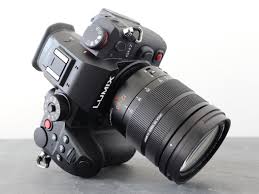
- Sensor: Micro Four Thirds
- Video: 6K at 60fps; 4K at 120fps
- Stabilization: 5-axis in-body
- Display: 3-inch free-angle touchscreen
- Audio: Dual XLR input support
- Weight: ~823g
- Price: ~$1,999 (body only)
Pros:
- Exceptional video quality with ProRes and RAW support
- Robust build with active cooling for extended recording
- Wide range of compatible lenses
Cons:
- Heavier and bulkier than other options
- Higher price point
Best For: Professional videographers and content creators requiring advanced video capabilities.
4. Fujifilm X-S20 – Best Hybrid Photo and Video Camera
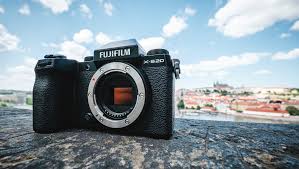
- Sensor: APS-C X-Trans CMOS 4
- Video: 6.2K at 30fps; 4K at 60fps
- Stabilization: 5-axis in-body
- Display: 3-inch vari-angle touchscreen
- Audio: 3.5mm mic and headphone jacks
- Weight: 491g
- Price: ~$1,299 (body only)
Pros:
- Excellent image quality with film simulation modes
- Compact and lightweight design
- Strong battery life
Cons:
- Limited lens selection compared to other brands
- No built-in flash
Best For: Content creators who require high-quality photo and video capabilities in one device.
5. Sony ZV-E1 – Best Full-Frame Vlogging Camera
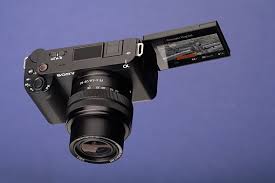
- Sensor: Full-frame Exmor R CMOS
- Video: 4K at 60fps; 4K at 120fps (with firmware update)
- Stabilization: 5-axis in-body
- Display: 3-inch vari-angle touchscreen
- Audio: Multi-Interface Shoe with digital audio interface
- Weight: 483g
- Price: ~$2,199 (body only)
Pros:
- Outstanding low-light performance
- Advanced AI-based autofocus
- Compact for a full-frame camera
Cons:
- No mechanical shutter
- Limited to 4K resolution
Best For: Professional vloggers seeking full-frame quality in a compact body.
6. Canon PowerShot V10 – Best Entry-Level Vlogging Camera
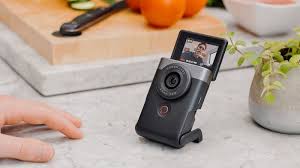
- Sensor: 1-inch CMOS
- Video: 4K at 30fps
- Lens: 19mm f/2.8 equivalent
- Display: 2-inch touchscreen
- Audio: Built-in stereo microphones
- Weight: 211g
- Price: ~$429
Pros:
- User-friendly interface
- Compact and lightweight
- Built-in stand for easy setup
Cons:
- Fixed lens with no zoom
- Limited manual controls
Best For: Beginners looking for a straightforward, portable vlogging camera.
7. GoPro HERO13 Black – Best Action Vlogging Camera

- Sensor: 1/1.9-inch CMOS
- Video: 5.3K at 60fps; 4K at 120fps
- Stabilization: HyperSmooth 6.0
- Display: Front and rear touchscreens
- Audio: Three microphones with advanced wind noise reduction
- Weight: 154g
- Price: ~$399
Pros:
- Rugged and waterproof design
- Excellent stabilization for action shots
- Versatile mounting options
Cons:
- Short battery life during high-resolution recording
- Limited low-light performance
Best For: Adventure vloggers and action sports enthusiasts.
8. Insta360 X4 – Best 360° Vlogging Camera
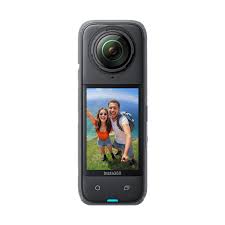
- Sensor: Dual 1/2-inch sensors
- Video: 8K at 30fps; 5.7K at 60fps
- Stabilization: FlowState stabilization
- Display: 2.29-inch touchscreen
- Audio: Four microphones with wind noise reduction
- Weight: 203g
- Price: ~$499
Pros:
- High-resolution 360° video capture
- Advanced stabilization for smooth footage
- Robust editing software with AI features
Cons:
- Requires post-processing for best results
- Limited battery life during 8K recording
Best For: Vloggers seeking immersive 360° content and creative shooting angles.
Comparison Table: Choose the Best for You Vlogging
| Camera Model | Sensor Size | Max Video Resolution | Stabilization | Weight | Price | Best For |
| Panasonic Lumix GH7 | Micro Four Thirds | 6K at 60fps | 5-axis in-body | 823g | $1,999 | Pro videography, cinematic vlogs |
| Fujifilm X-S20 | APS-C | 6.2K at 30fps | 5-axis in-body | 491g | $1,299 | Hybrid creators (photo + video) |
| Sony ZV-E1 | Full-frame | 4K at 120fps | 5-axis in-body | 483g | $2,199 | High-end vlogging, cinematic content |
| Canon PowerShot V10 | 1-inch | 4K at 30fps | Electronic | 211g | $429 | Entry-level users, compact simplicity |
| GoPro HERO13 Black | 1/1.9-inch | 5.3K at 60fps | HyperSmooth 6.0 | 154g | $399 | Action, adventure, outdoor vlogging |
| Insta360 X4 | Dual 1/2-inch | 8K 360° at 30fps | FlowState stabilization | 203g | $499 | Immersive 360° content, creative shots |
Real-World Applications of Vlogging Cameras
YouTube Creators
Vloggers on YouTube demand:
- Crisp 4K or 6K footage
- Accurate face tracking
- Good audio with external mic support
Popular Picks:
- Sony ZV-E1 – for cinematic background blur and real-time tracking.
- Canon PowerShot V10 – perfect for beginners with plug-and-play ease.
Amazon Review Insight:
“The ZV-E1 blew my mind with its low-light performance. My channel’s engagement jumped after switching!” – ★★★★★ Verified Buyer
Travel Vloggers
On-the-go creators need:
- Lightweight builds
- Long battery life
- Flip screens for selfies
Top Recommendations:
- DJI Osmo Pocket 3 – stabilizer and camera in one.
- Fujifilm X-S20 – compact, yet professional.
Reddit Feedback:
“Took the Osmo Pocket through Bali – fits in my pocket and survived the heat and rain!”
Live Streamers
Live creators require:
- Clean HDMI or USB webcam output
- Reliable autofocus
- Good audio capture
Suggested Cameras:
- Sony ZV-1 II – with webcam mode via USB.
- Panasonic GH7 – pro-grade streaming via HDMI.
Pro Tip: Pair with a capture card for platforms like Twitch and YouTube Live.
Action Sports Enthusiasts
These users want:
- Rugged design
- Wide-angle lens
- Advanced stabilization
Go-To Models:
- GoPro HERO13 Black – best for biking, snowboarding, surfing.
- Insta360 X4 – great for 360° storytelling and POV footage.
Amazon User Insight:
“I mounted the HERO13 on my helmet – insane stabilization even on rocky trails!”
Buying Tips: How to Choose the Best Vlogging Camera
Budget Considerations
Before diving into features, define your budget range. Whether you’re a beginner or seasoned creator, you can find powerful options:
- Under $500: Compact cameras like Canon PowerShot V10 or DJI Pocket 2.
- $500–$1,200: Mid-tier mirrorless models like Sony ZV-E10 or Fujifilm X-S20.
- $1,200+: Professional-grade options like Sony ZV-E1 or Panasonic GH7.
Tip: Don’t overspend on features you may not use early on. Focus on cameras that match your immediate needs.
Feature Prioritization
Not all vloggers have the same workflow. Prioritize features based on your content style:
- For daily vloggers: Look for flip screens, fast autofocus, and compact design.
- For travel: Lightweight, weather-sealed builds, and long battery life matter.
- For product reviewers: Crisp autofocus, bokeh, and external mic support are key.
- For streamers: Clean HDMI or webcam mode is essential.
🎙 Pro tip: Audio matters just as much as video. Choose a camera with a good internal mic or mic input port.
Future-Proofing
Think ahead—your skills and needs will grow over time:
- Lens compatibility: Go for interchangeable lens systems like Sony E-mount or Canon RF.
- 4K 60fps or higher: To stay competitive with evolving video standards.
- Expandable accessories: Consider cameras that support mics, lights, gimbals, etc.
Example: A camera like the Sony ZV-E10 starts off beginner-friendly, but has room to scale with pro lenses and mics.
Common Queries related Vlogging Camera
Best Camera for Vlogging and Photography
Look for a hybrid camera with both strong video and still image performance.
Top Pick: Sony ZV-E10 – Interchangeable lens, great 4K video, and solid 24MP stills.
Runner-Up: Canon EOS R50 – Excellent for crisp photos and cinematic vlogging.
Vlogging Cameras for Beginners
Beginners need something easy-to-use, lightweight, and affordable with good audio/video.
Top Pick: Canon PowerShot V10 – Built-in stand, vertical video, no learning curve.
Runner-Up: Sony ZV-1 – Compact, flip screen, and amazing autofocus.
Best Camera for Vlogging 4K
If you’re all about ultra-clear content, 4K resolution is a must.
Top Pick: Sony ZV-E1 – Full-frame 4K60fps, stunning low light, pro-level quality.
Budget 4K Option: DJI Pocket 3 – 4K60 with 3-axis stabilization in your pocket.
Best Vlogging Camera Cheap
On a tight budget? Go for cameras under $300 that still deliver great value.
Top Pick: AKASO Brave 8 – Action cam with 4K, great for beginners.
Runner-Up: Canon PowerShot V10 – Vlogger-focused, no-fuss setup.
Best Phone Camera for Vlogging
Modern smartphones can now rival traditional cameras.
Top Pick: iPhone 15 Pro Max – Cinematic mode, 4K60fps, excellent stabilization.
Android Pick: Samsung Galaxy S24 Ultra – 200MP camera, pro video tools.
Best Camera for Vlogging 2025
This year’s best combines cutting-edge features with creator-first design.
Top Pick: Sony ZV-E1 – Full-frame, AI-tracking autofocus, 4K120fps.
Close Second: Fujifilm X-S20 – Retro look, vlogging mode, excellent color science.
Insta360 Vlogging Camera
Perfect for immersive, creative, and 360-degree content.
Top Pick: Insta360 X4 – 8K 360 capture, FlowState stabilization, waterproof.
Why Use It? Great for travel, sports, and content that stands out on social media.
DJI Vlogging Camera
DJI offers compact gimbal-stabilized vlogging cameras with pro-level footage.
Top Pick: DJI Pocket 3 – Built-in gimbal, 4K60fps, flip screen, mic input.
Why Choose DJI? If you vlog while walking/moving, DJI gives butter-smooth video.
FAQ’s about Best Camera for Vlogging
What camera do most vloggers use?
Most vloggers use the Sony ZV-1 or Sony ZV-E10, thanks to their excellent autofocus, compact design, flip screens, and great video quality. More advanced creators may use the Sony ZV-E1 or Canon EOS R50 for higher-end content.
What is the best vlog camera for beginners?
The Canon PowerShot V10 is ideal for beginners—it’s affordable, has built-in stabilization, and is easy to use. The Sony ZV-1 is another great pick for those wanting better video quality and more control.
What camera do a lot of YouTubers use?
Popular YouTubers often use the Sony ZV-E10, Canon EOS R50, or Fujifilm X-S20 for their hybrid photo-video capability. Some also favor mirrorless full-frame cameras like the Sony A7C II for more cinematic results.
Is GoPro OK for vlogging?
Yes, a GoPro is great for action or travel vlogging. It’s waterproof, ultra-wide, and super stable. However, it’s less ideal for talking head content or low-light scenes where traditional vlogging cameras perform better.
What to avoid in vlogging?
Avoid:
- Poor audio – Always prioritize clear sound.
- Shaky footage – Use stabilization or a tripod.
- Bad lighting – Natural light or a ring light helps.
- Long intros – Get to the point quickly to retain viewers.
Is iPhone or GoPro better for vlogging?
An iPhone is more versatile for indoor and talking content with better overall image processing. A GoPro shines outdoors and for action or travel vlogging. For most creators, the iPhone offers more flexibility.
Which device is best for vlog?
For versatility: Sony ZV-1 or iPhone 15 Pro Max
For action/travel: GoPro Hero12 or DJI Pocket 3
For pro quality: Sony ZV-E1 or Canon R50
How do I choose a vlogging camera?
Consider:
- Budget – Stay within your means.
- Stabilization – Crucial for smooth footage.
- Flip screen – So you can see yourself.
- Audio input – External mics improve sound.
- Video resolution – At least 1080p, preferably 4K.
Why use a GoPro instead of a phone?
Use a GoPro when you need:
- Hands-free, rugged filming
- Waterproof capabilities
- Ultra-wide, immersive shots
- Mounting options for unique angles
What is the drawback of GoPro?
- No zoom lens
- Limited depth of field for cinematic looks
- Smaller sensor = lower low-light performance
- Can overheat during long 4K recordings
What is the best camera for a beginner?
The Canon PowerShot V10 is the easiest to start with. If you want more flexibility as you grow, go with the Sony ZV-1 or Canon EOS R50—both are beginner-friendly but offer room to advance.
Can you take still photos with a GoPro?
Yes! GoPros can take high-resolution still images. Newer models like the GoPro Hero12 Black support RAW photo capture, burst mode, and time-lapse photography—great for both action shots and everyday use.
Conclusion: Find the Best Camera to Match Your Vlogging Journey
Choosing the best camera for vlogging depends on your content style, budget, and goals. Whether you’re just starting out or you’re a seasoned creator, the right gear can elevate your videos with sharper visuals, clearer audio, and smoother performance.
From compact powerhouses like the Sony ZV-1 to hybrid favorites like the Canon EOS R50, and rugged options like the GoPro Hero12, there’s a perfect camera for every vlogger—be it for YouTube, travel, lifestyle, or live streaming.
Don’t just follow trends—match your camera to your creative needs. Prioritize features that matter most to you, like stabilization, audio, portability, or future-proof capabilities. As your content evolves, so should your gear.
Ready to upgrade your vlogging setup?
Explore our top picks and find your perfect camera today.
➡️ Click here

